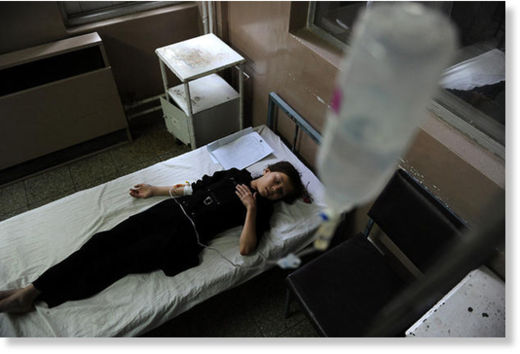
No one has died from the mysterious illness and most recover within a day or two. This is the fourth straight year the illness has afflicted Afghan girls in the northern provinces although there has been a dramatic spike in 2012 - 858 cases reported in the first five months alone compared to 119 last year.
The provincial governments and Kabul say the girls are being poisoned by the Taliban, or Pakistani spies, because they are attending school - something that was forbidden during the Taliban rule in the 1990s. The radical group has denied any involvement.
But the World Health Organization believes it has found the cause: mass hysteria, or, in medical parlance, mass psychogenic illness (MPI).
"In the last four years over 1,634 cases from 22 schools have been treated for mass psychogenic illness in Afghanistan," says a report from the WHO in late May.
Locals and the government vehemently disagree.
"Girls are being poisoned," said Nargis Nehan, with Equality for Peace and Democracy, from Kabul. "It's that simple. There must be something in the water or air that is making these girls sick."
Neither the World Health Organization nor local officials have found evidence of poison. Tests on the girls have come back negative in all 1,634 cases, according to the WHO report. And no teachers or boys have become sick.
"Hundreds of girls are getting sick, physically sick and have to be taken to the hospital," said Manizha Naderi, executive director with New York-based Women for Afghan Women. "How can that be mass hysteria?"
Mass hysteria manifests itself in physical symptoms and is a legitimate illness, according to Julio Arboleda-Florez, a psychiatry and epidemiology professor at Queen's University. But it's hard to get that message across.
"People have trouble accepting this diagnosis because people aren't very psychologically sophisticated," Arboleda-Florez said.
Mass hysteria is a well-documented phenomenon. The professor studied an episode in the West Bank in which nearly 1,000 school girls felt nauseous and fainted. It came during the threat of chemical warfare from Israel.
"There is usually a tremendous amount of anxiety that leads to mass hysteria," Arboleda-Florez said. "It's a social behaviour that is often correlated with war and mass hysteria that happens when someone is completely overcome and cannot control their environment."
. It often happens in war-torn countries where there are legitimate fears - such as the threat of poisoning in Kosovo in 1990, when thousands of girls suffered from burning red eyes and chest pain. It affected almost exclusively ethnic Albanians during the deadly civil war. But no traces of poison were ever found in the patients.
"This is all based on anxiety, and I mean extreme anxiety, where there are real, plausible threats," said Robert Bartholomew, a sociology professor from Botany College in Auckland, who has studied the phenomenon. "The fact that schoolgirls have been targeted in the past by the Taliban only serves to give credence to the rumours of a potential poison attack."
Strangely, the Afghan government arrested 15 people in May, said to be responsible for the poisonings. Seven more were arrested for a different episode on Tuesday. Two of those suspects were trotted out to speak to the BBC, admitting they poisoned girls. An intelligence officer directed every response by the accused.
The illnesses occur in clusters. More than 100 girls from Bibi Hajerah High School in the northern Takhar province went to the hospital after becoming weak, nauseous and dizzy in May. There have been similar-sized outbreaks at other schools in the north this year. Many girls said they smelled an awful stench immediately before falling ill.
"Generally, one person gets sick and then it's like dominoes," Bartholomew said. "And what's interesting is that everyone's symptoms are similar."
Mass hysteria overtook Le Roy, N.Y. in January when 18 teenage girls, one boy and a 36-year-old woman came down with tics, spasms and fainting spells, although experts agree it's a little more complicated because there's no war in Le Roy.
But in Afghanistan, many of the girls who have recovered haven't returned to school. The fear is real, Rumours that girls who've gotten ill can't have children aren't helping matters.
"Now people think that their girls who have gotten sick can't have children and their lives are ruined, so parents are keeping their girls home," Naderi said.
Psychotherapy won't work, but the solution is simple.
"It's a social ailment," Arboleda-Florez said. "They just need to get away from their environment and the stress. And a hospital is a good place to do that."



Reader Comments
to our Newsletter